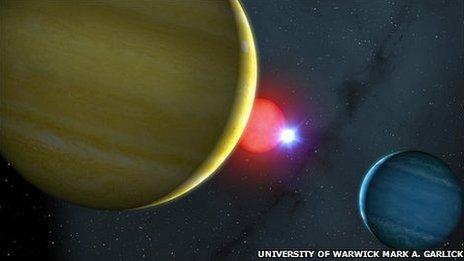Scientists find star system 'like a game of snooker'
- Published

Researchers created an artist's impression of the star system they helped find
Astronomers at Warwick and Sheffield universities have discovered a star constellation which they say strongly resembles a game of snooker.
NN Serpentis is made of two binary stars - a red dwarf and a white dwarf - which orbit each other about 1,670 light years away from Earth.
Researchers said there were reasons to believe their behaviour was influenced by two giant, unseen, gas planets.
They compared the position of the planets and stars to a snooker frame.
An international team of scientists observed that the larger red dwarf eclipsed the white one at three hour and seven minute intervals.
'Vast shock'
Occasionally there were irregularities in their orbits, which they said had to be caused by the gravitational pull of two large planets, not detected by the astronomical camera the British scientists had helped to develop.
Professor Tom Marsh, from the University of Warwick's physics department, said: "The two gas giants have different masses but they may actually be roughly the same size as each other, and in fact will also be roughly the same size as the red dwarf star they orbit.
"If they follow the patterns we see in our own star system of gas giants with dominant yellow or blue colours, then it's hard to escape the image of this system as being like a giant snooker frame with a red ball, two coloured balls, and a dwarf white cue ball."
The bigger of the two gas giants is thought to be about six times the mass of Jupiter and orbits the binary star every 15-and-a-half years. The smaller planet orbits every seven-and-three-quarter years and is thought to be about 1.6 times the mass of Jupiter.
Professor Vik Dhillon, from the University of Sheffield, said: "If these planets were born along with their parent stars they would have had to survive a dramatic event a million years ago: when the original primary star bloated itself into a red giant, causing the secondary star to plunge down into the present very tight orbit, thereby casting off most of the original mass of the primary. Planetary orbits would have seen vast disturbances.
"Alternatively, the planets may have formed very recently from the cast off material. Either way, in relatively recent times in astronomical terms this system will have seen a vast shock to the orbits of the stars and planets, all initiated by what is now the white dwarf at the heart of the system."